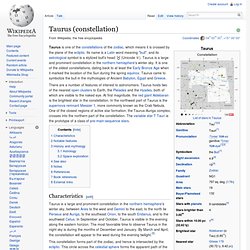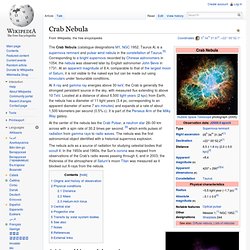

Taurus. Taurus_IAU. Taurus (constellation) Taurus is one of the constellations of the zodiac, which means it is crossed by the plane of the ecliptic.

Its name is a Latin word meaning "bull", and its astrological symbol is a stylized bull's head: (Unicode ♉). Taurus is a large and prominent constellation in the northern hemisphere's winter sky. It is one of the oldest constellations, dating back to at least the Early Bronze Age when it marked the location of the Sun during the spring equinox.
Taurus came to symbolize the bull in the mythologies of Ancient Babylon, Egypt and Greece. This constellation forms part of the zodiac, and hence is intersected by the ecliptic. The recommended three-letter abbreviation for the constellation, as adopted by the International Astronomical Union in 1922, is "Tau".[2] The official constellation boundaries, as set by Eugène Delporte in 1930, are defined by a polygon of 26 segments. Pleiades. Observational history[edit] The Pleiades are a prominent sight in winter in both the Northern Hemisphere and Southern Hemisphere, and have been known since antiquity to cultures all around the world, including the Māori, Aboriginal Australians, the Persians, the Arabs (known as Thurayya), the Chinese, the Japanese, the Maya, the Aztec, and the Sioux and Cherokee.

In Tamil culture this star cluster is attributed to Lord Murugan (Lord Murugan raised by the six sisters known as the Kārththikai Pengal and thus came to be known as Kārtikeyan). In Sanskrit he is known as Skanda. The Nebra sky disk, dated c. 1600 BC. Crab Nebula. Chandra, Hubble, and Spitzer image NGC 1952 At X-ray and gamma ray energies above 30 keV, the Crab is generally the strongest persistent source in the sky, with measured flux extending to above 10 TeV.

Located at a distance of about 6,500 light-years (2 kpc) from Earth, the nebula has a diameter of 11 light years (3.4 pc, corresponding to an apparent diameter of some 7 arc minutes) and expands at a rate of about 1,500 kilometers per second (0.5% c). It is part of the Perseus Arm of the Milky Way galaxy. At the center of the nebula lies the Crab Pulsar, a neutron star 28–30 km across with a spin rate of 30.2 times per second, [6] which emits pulses of radiation from gamma rays to radio waves. The nebula was the first astronomical object identified with a historical supernova explosion. Origins and history of observation[edit] The Stellar Sisters. Happy Matariki everyone!

It’s that time of the year when we approach the shortest day and Matariki appears low in the East in our morning sky just before the sunrise. To find it follow the line of the stars from Orion’s belt (Tautoru in Maori) towards the North – past a red star (Aldebaran) and to a small clump of stars; the “Eyes of God” or Matariki. Matariki as seen by Spitzer Space Telescope Depending on eyesight and viewing conditions people are usually able to make out between 7 and 14 stars within this cluster with the naked eye, although in reality there are over 1000 members. Known as the Pleiades, the daughters of the titan Atlas in greek folklore and as Subaru in Japan, this cluster is almost always associated with celebrations of rebirth and regeneration, most likely due to its appearance’s proximity to the Northern solstice (shortest day), when the tide of Winter turns and we begin to move towards warmer months once again.
Main Matariki stars So why do I include this? The Hunter and the Bull. My astronomy posts are based on what I talk about each week at Carter Observatory during planetarium shows and telescope viewing sessions.

Much of the information is gleaned from the monthly summaries provided by the excellent Alan Gilmore at the University of Cantebury’s Mt John Observatory which can be accessed (for April) here: Personally I remember the main stars, and their colours an then use imaginary lines to navigate the sky, unfortunately this is not particularly well facilitated by the currently available star chats (which are still great though), visible on the right, so I will be editing small portions of the star charts, to allow colour comparison and for general ’prettyness’ (and also to teach myself Inkscape – BTW if you would like to similarly learn here‘s a nice place to start!)
Orion’s Belt is a great way to navigate and memorize his part of the sky.